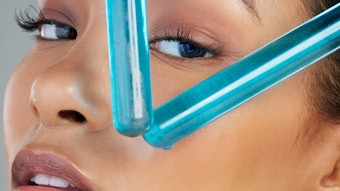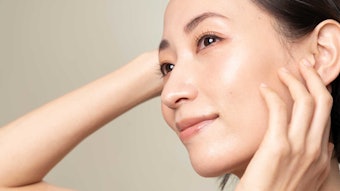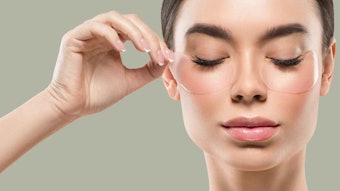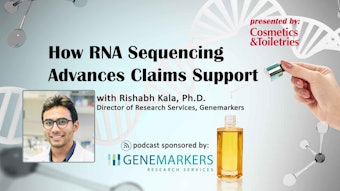
Facial pores are characterized by the enlarged openings of pilosebaceous follicles that promote visible topographical features at the skin surface.1, 2 These are an especially important, unsightly problem to women. The biological mechanisms underlying pore formation remain unclear but several determinants are involved. These include factors of exogenous and endogenous origin such as ethnicity, sex, aging and chronic UV exposure.3 Skin disorders such as acne, or a genetic predisposition can also endorse their presence.3
Among the most relevant explanations for pore formation are the loss of skin elasticity and excessive sebum secretion, which are subject to significant modifications with age; these were identified by Sang4 and Roh.5 Indeed, a significant decrease in skin elasticity is observed with age, which is correlated to a significant increase in oxidative stress.6 The latter promotes the production of reactive oxygen species (ROS) coupled to the over-expression of extracellular matrix (ECM) proteolytic enzymes; e.g., metalloproteinases (MMPs).7, 8
MMPs are well-known to degrade type I collagen, the most essential collagen in the dermis for the skin’s structure.9 ROS also induce the degradation of tropoelastin and microfibril-associated glycoprotein-1—critical ECM proteins for elastic fiber assembly—which leads to the loss of elastin in the ECM.10, 11 The fragmentation of these ECM components results in the slackening of skin pore walls.12 This effect is highly amplified by UV and correlated to skin collapse, which ultimately decreases the skin’s tensile strength around facial pores and favors their enlargement.13
Furthermore, excessive sebum production can enlarge facial pores by clogging them.3, 5 Variations in sebum production have been reported according to gender and age; for example, in women, aging is associated with drastic hormonal changes during menopause that lead to androgenic up-regulation.14 These relevant hormones, such as testosterone,15 in turn stimulate sebum production and can influence the appearance of clogged and enlarged facial pores with age.16, 17
Again, this effect can be amplified by UV irradiation, which has been shown to up-regulate sebum production and exacerbate pore size.18 Indeed, UV-induced sebaceous gland hyperplasia has been described at the in vivo level;19 this observation was reinforced by Akitomo et al., who demonstrated a significant increase in sebocyte numbers and lipid production after sunlight exposure, compared with non-irradiated controls.18, 20
It is worth noting one positive effect of the UV-induced increase in sebum production: the lipid-rich sebum secreted on the skin protects it from UV radiation. But then again, UV also promotes lipid peroxidation;18 so although sebum can protect against UV, UV directly influences ROS production, which triggers sebum peroxidation.7 Indeed, photo-oxidized squalene has been shown to act as an oxidative molecule that has dramatic consequences in skin; such as altering the epidermal barrier and causing premature aging.18, 20
Oxidative stress related to UV exposure clearly can act as a key factor in the early appearance of conspicuous skin facial pores. Therefore, in the present study, the authors hypothesized that a potent antioxidant molecule could be an efficient strategy to prevent the premature formation of enlarged and clogged facial pores. First, they explored the antiox-idant activity of a specialized trihydroxybenzoic acid glucoside (THBG) molecule in tubo and in vitro. Then, its impact on the reduction of facial pores was evaluated in a clinical trial with Korean panelists.
Materials and Methods
Reagent: As noted, the active ingredient used in the described studies is a unique THBG molecule obtained by biocatalysis that includes traces of trihydroxybenzoic acid (THBA)a. The production process is described in EP2027279 B1. Previous investigations showed THBG is cleaved by a specific glucosidase from skin microbiota, which leads to THBA release on the skin.21 Furthermore, THBA, or gallic acid, is known for its antioxidant activity.
DPPH assay: To assess antioxidant activity, THBG and its non-glycosylated form, THBA, were solubilized in ethanol. N-Acetyl cysteineb (NAH) and vitamin Cc were used as a positive control and solubilized in ethanol. Compounds were diluted to a specific range of concentrations, i.e., between 0 μM and 400 μM, depending on the component, in 96-well micro-plates (100 μL). The solvent alone, ethanol, served as the control.
A 50-mM stock solution of α,α-diphenyl-β-picrylhydrazyl (DPPH)d was prepared by dissolving 19.7 mg DPPH in 10 mL of ethanol, to which a 300-μM intermediate solution was added. Then, 100 μL of DPPH solution (final concentration 150 μM) was added to each well. The plate was shaken to ensure a thorough mixing before being wrapped with aluminium foil and placed in the dark. After 15 min, the optical density (OD) was read at a wavelength of 540 nm using a microplate readere.
All tests were run at least in triplicate and averaged. The inhibitory effect of various molecules was calculated as a percentage of the control using the following formula:
% inhibition = [1-OD (DPPH + sample)/OD (DPPH alone)] × 100
The EC50 (half of the effective concentration) was defined as the concentration of tested compound at which a response halfway between the baseline and maximum is induced, under the defined conditions of exposure.
DNA protection, or “photoprotection” comet assay: Human primary melanocytesf were dispensed into 35-mm diameter tissue culture dishes (1 × 105 cells/dish). After cell recovery and adherence, cells were pre-incubated in buffers with the THBG ingredient at 0.2%, 0.4% and 2%; or a reference compound at the determined concentrations for 24 hr (37°C, 5% CO2); or with methyl methanesulfonate (MMS)f at 60 μM for 2 hr.
The light source used was a solar simulatorg, whose irradiance was fixed at 750 W m2 throughout the experiments. To ensure broad-spectrum irradiation, the combined light dose was 4.5 J/cm2 for 1 min, corresponding to 0.28 J/cm2 for UVA, 0.08 J/cm2 for UVB and 4.14 J/cm2 for visible light. This irradiation dose equates to a 1-3 min period of solar exposure during a clear summer day in the United Kingdom.22 Cells embedded in agarose on comet slides were irradiated at 4°C on a bed of ice and the comet assay was performed immediately after irradiation, as described previously.23, 24
The assay was carried out under yellow light to prevent any additional damage potentially induced by natural light. Briefly, cells were harvested, centrifugated and resuspended in 75 μL of solution of 0.5%, low-melting point agarose (LMP) at 37°C. Cells suspensions (5 × 104) were placed on microscope slides previously coated with 1.8% agarose and layered with 85 μL of solidified 0.8% agarose gel. After application of a third layer of LMP agarose, slides were immersed in cold lysis solution for 90 min at 4°C. The microscope slides were then placed in an electrophoresis tank, where DNA was allowed to unwind in freshly prepared alkaline electrophoresis buffer for 20 min at room temperature. Electrophoresis was carried out for 20 min at 25 V and 300 mA. The slides were then washed three times with a cold neutralizing buffer for 5 min and dehydrated in pure methanol.
Each slide was stained with 50 μL of 2 μg/mL ethidium bromide and covered with a coverslip. The slides were then analyzed with a fluorescence microscope equipped with an oil immersion lens connected to a high-sensitivity electron-multiplied charge-coupled device camera. The final magnification was 400×.
A total of 50 randomly selected cells were analyzed per slide using image analysis softwareh. DNA damage was expressed as the Olive Tail Moment (OTM), described in arbitrary units as: OTM = Tail DNA% × Tail Moment Length; where Tail Moment Length is measured from the center of the head to the center of the tail. A total 100 OTM values were determined for each sample; 50 from each of two separate slides/sample. Comparisons of means were performed using statistical analysisj, and a 0.05 level of probability was used as the criterion for significance.
For the comet assay, the 100 calculated OTM values/sample were distributed into 40 classes between the minimal and the maximal values. A nonlinear regression analysis was performed on the OTM distribution frequencies by using a Χ2 function and softwarek. The calculated degrees of freedom (n) for this function were quantitative measures of the DNA damage for a sample.25, 26 The n value was termed Χ2 OTM and used as the sole parameter for assessing levels of DNA damage. The significance of the differences between Χ2 OTM values of control and treated cells was analyzed using the student’s t-test.
Photo-oxidized squalene has been shown to act as an oxidative molecule that has dramatic consequences in the skin.
Clinical Trial Protocol
A double-blind and placebo-controlled clinical evaluation was carried out in 20 Korean women between the ages of 30 and 60 (mean age = 46 ± 7 years) showing conspicuous facial pores; all subjects participating provided informed consent. The effect of the THBG blend at 2% on facial pores was evaluated before application (day zero—D0) and after 14, 28 and 56 days of product use.
Twice daily, volunteers applied a placebo cream to one side of their face and a cream containing the test ingredient to the other. Digital picturesm were taken at each study point (D0, D14, D28 and D56) and used to analyze the pore score—i.e., the percentage of the skin’s surface showing detectable pores. The results were retrieved as absolute scores.
As noted, pores are external circular openings of the sebaceous glands. Due to shading, pores appear darker than the average tone of skin and are therefore identifiable by their darkness and circular shape. Here, an absolute scores factor was used to combine the total size, diameter and area of detected pores to estimate the number and area of pores for each subject’s face. Absolute scores can be used to track treatment progress when the size of facial pores is the most relevant indicator of treatment effectiveness. One measure was calculatedm for each parameter, on each volunteer and for each product tested; only their average was taken into account.
Statistical analysis: Paired student t-tests were performed to compare each condition with the product and their respective controls, as well as the conditions treated with the active agent relative to the condition treated with placebo. The significance of comparisons are indicated as follows: * = p < 0.05; ** = p < 0.01; and *** = p < 0.001.
Results: Antioxidant Activity
As stated, the active ingredient contains both THBG and traces of THBA. THBA, or gallic acid, is known for its antioxidant properties. Here, both THBG and THBA showed intrinsic antioxidant properties, as seen by the concentration-dependent increase in percentage of DPPH reduction (see Figure 1). Indeed, DPPH is a stable free radical; upon accepting hydrogen from a corresponding donor, its solutions loses its characteristic deep purple color.
The anti-radical-scavenging activity was stronger with THBA than THBG, although both ingredients were more effective in DPPH reduction than the controls N-acetyl cysteine and vitamin C (see Figure 1). The antioxidant power of THBA was 5× that of THBG, as demonstrated by EC50 values and 4× that of vitamin C—indicating the antioxidant power of THBG is comparable to that of vitamin C.
Results: Protection from UV-induced DNA Lesions
THBG was hypothesized to effectively protect against DNA lesions mediated by UV through its potent antioxidant property. Indeed, as noted, DNA damage is a consequence of reactive oxygen species production, mediated by broad spectrum irradiation.27 The comet assay was therefore used to investigate the effect of this ingredient at different doses on UV-mediated DNA lesions in human melanocytes.
UV irradiation induced a significant increase in DNA breaks: up to 6.2× (see Figure 2A). The comet assay was validated by MMS treatment, which showed an increase in DNA single strand breaks (data not shown). Pre-incubation with the THBG ingredient at all tested concentrations resulted in significantly lower levels of DNA single strand breaks after irradiation—close to levels of the non-irradiated condition (control).
Here, the THBG ingredient induced a dose-response relationship in protecting cells against DNA lesions induced by broad-spectrum irradiation in normal human melanocytes (see Figure 2A). The levels of broad-spectrum photoprotection ranged from 72.5% to 94.1% for 0.2% to 2% concentrations, respectively (see Figure 2A-B). This demonstrated the THBG ingredient has unique antioxidant activity and shows high efficacy against UV-induced DNA damage.
Clinical Efficacy: Pore Reduction
The loss of skin elasticity and firmness were described above as being key factors in premature facial pore appearance.3 Furthermore, chrono-aging and/or photo-aging promote uncontrolled oxidative stress that leads to skin damage such as dermal matrix degradation, which leads to premature facial pore formation.6, 28 However, since THBG exhibited potent antioxidant activity, it was hypothesized that the tested product could prevent the appearance of facial pores.
Here, digital imagingm was used in Korean panelists having visible facial pores to analyze the number and size of pores for each. Figure 3 presents the results corresponding to pore parameter, as calculatedm after 14, 28 and 56 days of twice daily application of placebo vs. the THBG ingredient at 2%. These results demonstrated a time-dependent, significant 8% decrease in the number of facial pores with the product at 2% after 56 days of treatment, in comparison with the placebo (see Figure 3). Figure 4 illustrates the results obtained after 56 days of application, in comparison with the placebo.
DPPH showed THBG and THBA had potent antioxidant activity. THBG was equal to vitamin C but, THBA showed 5× the activity.
Discussion
THBA itself is a potent antioxidant. However, it is physically not stable due to its chemical nature.29 Therefore, the present work describes a safe and stabilized molecule developed by glycosylation of THBA via biocatalysis with THBG, which is characterized by the addition of alpha-d-glucoside moieties. Furthermore, previously, the THBG form was found by Raman spectroscopy to penetrate better and deeper into the skin than THBA. In addition, in situ it was confirmed by skin microbiota collection techniques and metagenomics analysis that THGB is converted into THBA by microbiota at the surface of skin.21, 30 Indeed, the skin microbiota expressed the alpha glucosidase required to convert THGB into THBA.30
In this study, the authors propose the use of a unique antioxidant molecule to prevent enlarged and clogged facial pores. The molecule is composed of a majority of THBG with residual THBA, which is a stable form of gallic acid—a well-known antioxidant polyphenol.21 To this end, THBG and THBA were proven to have potent antioxidant activity, as observed by DPPH. THBG was approximately equivalent to vitamin C whereas THBA showed antioxidant activity 5× more efficient than vitamin C and THBG. This suggested the ingredient could become very efficient after skin microbiota-induced bio-activation.21
This unique antioxidant activity could also promote active protection against oxidative stress, which is observed during skin aging6 and whose effects are amplified during UV exposure, leading to photo-induced premature aging.31 In this precise case, in 2007, Auffray described the DPPH test as a convenient method to demonstrate protection from UV-induced lipid peroxidation.32 Antioxidant activity leads to efficient photo-protection, as observed by comet assays showing significant reductions in DNA lesions directly provoked by UV-mediated ROS production.27
Taken together, these results clearly demonstrate the THBG ingredient possesses high antioxidant activity. Thus, the authors considered its application to reduce the effects of UV and its associated oxidative stress in the appearance of prematurely enlarged facial pores. In addition, a recent review described polyphenols for the reduction of sebum production.33 And gallic acid, a potent antioxidant polyphenol, has been shown to exercise cytoprotective activities after UV irradiation34 by acting as an ROS scavenger and significantly reducing their quantity as well as lipid peroxidation.20 The authors therefore suggested that THBA from cleaved THBG could have similar effects.
Conclusions
As hypothesized, THBG was shown here in clinical tests to modulate facial pore size and number, demonstrating it is an efficient strategy to control and limit pore enlargement. Indeed, through oxidative stress protection, the ingredient’s effects on dermal matrix degradation and excessive sebum production—two main factors in the development of enlarged pores—were successful.
References
- G Pierard, P Elsner and R Marks, EEMCO guidance for the efficacy assessment of antiperspirants and deodorants, Skin Pharmacol Appl Skin Physiol 16 324-42 (2003)
- Y Sugiyama-Nakagiri, K Sugata, M Iwamura and A Ohuchi, Age-related changes in the epidermal architecture around facial pores, J Dermatol 151-4 (2008)
- B Kim, J Choi, K Park and S Youn, Sebum, acne, skin elasticity and gender difference—Which is the major influecing factor for facial pores? Skin Research and Technology 19 45-53 (2013)
- JL Sang, S Joon, J Se Yeong, P Kui Young, L Kapsok and S Seong Jun, Facial pores: Definition, causes and treatment options, Dermatologic Surgery 42 277-85 (2016)
- M Roh, M Han, D Kim and K Chung, Sebum output as a factor contributing to the size of facial pores, Br J Dermatol 155 890-4 (2006)
- M Rinnerthaler, J Bischof, MK Streubel, A Trost and K Richter, Oxidative stress in aging human skin, Biomolecules 5 545-89 (2015)
- K Gratz and B Kofler, UV irradiation-induced inflammation, What is the trigger? Exp Dermatol 24(112) 916-7 (2015)
- D Siwik, P Paqano and W Colucci, Oxidative stress regulates collagen synthesis and matrix metalloproteinase activity in cardiac fibroblasts, Am J Physiol Cell Physiol 53-60 (2001)
- GJ Fisher, T Quan, T Purohit, Y Shao, M Kyun Cho, T He, J Varani, S Kang and JJ Voorhees, Collagen fragmentation promotes oxidative stress and elevates matrix metalloproteinase-1 in fibroblasts in aged human skin, Am J Pathol 101-14 (2009)
- A Hayashi, A Ryu, T Suzuki, A Kawada and S Tajima, In vitro degradation of tropoelastin by reactive oxygen species, Arch Dermatol Res 290(19) 497-500 (1998)
- G Svineng, C Ravuri, O Rikardsen, N Husebi and J Winberg, The role of reactive oxygen species in integrin and matrix metalloproteinase expression and function, Connect Tissue Res 49(13) 197-202 (2008)
- S Keiichi, N Takafumi, K Takashi and T Yoshinori, Confocal laser microscopic imaging of conspicuous facial pores in vivo: Relation between the appearence and the internal structure of skin, Skin Res Technology 14 208-12 (2008)
- L Ritiié and GJ Fisher, UV light-induced signal cascades and skin aging, Ageing Res Rev 705-20 (2002)
- H Burger, E Dudley, D Robertson and L Dennerstain, Hormonal changes in the menopause transition, Recent Progress in Hormone Research 57 257-75 (2002)
- G Laughlin and E Barrett-Connor, Postmenopausol testosterone, J Clin Endocrinol Metab 86 1843-46 (2001)
- M Downie, R Guy and T Kealey, Advances in sebaceous gland research: Potential new approaches to acne management, Int J Cosmet Sci 26 291–311 (2004)
- J Imperato-McGinley, T Gautier, L Cai, B Yee, J Epstein and P Pochi, The androgen control of sebum production. Studies of subjects with dihydrotestosterone deficiency and complete androgen insensitivity, J Clin Endocrinol Metab 76 524-28 (1993)
- Y Akitomo, H Akamatsu, Y Okano, H Masaki and T Horio, Effects of UV irradiation on the sebaceous gland and sebum secretion in hamsters, J Dermatol Sci 31(12) 151-9 (2003)
- JH Epstein, K Fukuyama and K Fye, Effects of ultraviolet radiation on the mitotic cycle and DNA, RNA and protein synthesis in mammalian epidermis in vivo, Photochem Photobiol 12(11) 57-65 (1970)
- A Oyewole and M Birch-Machin, Sebum, inflammasomes and the skin: Current concepts and future perspective, Exp Dermatol 24(19) 651-4 (2015)
- H Chajra, G Redziniak, D Auriol, K Schweikert and F Lefevre, Trihydroxybenzonic acid glucoside as a global skin color modulator and photo-protectant, Clinical, Cosmetic and Investigational Dermatology (2015)
- BL Diffey, Sources and measurement of ultraviolet radiation, Methods 4-13 (2002)
- M De Meo, Genotoxic activity of potassium permanganate in acidic solutions, Mutat Res 295-306 (1991)
- D Anderson and M Plewa, The International Comet Assay workshop, Mutagenesis 67-70 (1998)
- S Jean, M De Méo, A Sabatier, M Laget, J Hubaud, P Verrando and G Duménil, Evaluation of sunscreen protection in human melanocytes exposed to UVA or UVB irradiation using the alkaline comet assay, Photochem Photobiol 74(13) 417-23 (2001)
- E Bauer, R Recknagel, U Fiedler, L Wollweber, C Bock and K Greulich, The distribution of the tail moments in single cell gel electrophoresis (comet assay) obeys a chi-square (chi2) not a gaussian distribution, Mutat Res 398(11-2) 101-10 (1998)
- RP Rastogi, A Kumar, MB Tyagi and RP Sinha, Molecular mechanisms of ultraviolet radiation-induced DNA damage and repair, Journal Nucleic Acids 32 (2010)
- SE Fligiel, SC Datta, S Kang and GJ Fisher, Collagen degradation in aged/photodamaged skin in vivo and after exposure to matrix metalloproteinase-1 in vitro, J Invest Dermatol 120(15) 842-48 (2003)
- A Eslami, W Pasanphan, B Wagner and G Buettner, Free radicals produced by the oxidation of gallic acid: An electron paramagnetic resonance study, Chem Cent J 4-15 (2010)
- H Chajra, D Auriol, K Schweikert, C Jarrin, P Robe, G Redziniak and F Lefevre, A product approach for development of a global skin tone modulating agent: 3,4,5-Trihydroxybenzoic acid glucoside (THBG) activated by skin microbiota metabolism, IFSCC Magazine 23-30 (2015)
- S Pillai, C Oresajo and J Hayward, Ultraviolet radiation and skin aging: Roles of reactive oxygen species, inflammation and protease activation, and strategies for prevention of inflammation-induced matrix degradation—A review, Intl J Cosmet Sci 27 17-34 (2005)
- B Aufray, Protection against singlet oxygen, the main actor of sebum squalene peroxidation during sun exposure, using Commiphora myrrha essential oil, Intl J Cosmet Sci 29(11) 23-9 (2007)
- S Saric, M Notay and R Sivamani, Green tea and other tea polyphenols: Effects on sebum production and Acne vulgaris, Antioxidants (Basel) 6(11) (2016)
- R Sanchez-Sanchez et al, Cytoprotective effect of the enzyme-mediated polygallic acid on fibroblast cells under exposure of UV-irradiation, Mater Sci Eng C Mater Biol Appl 76 417-24 (2017)











